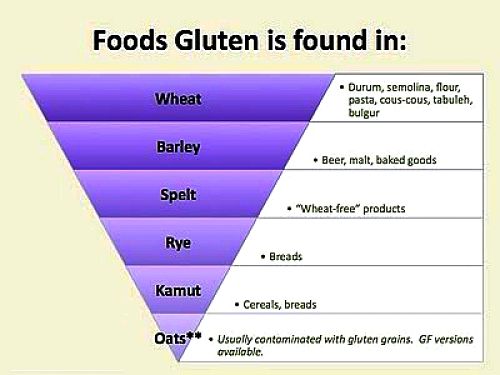Coeliac Disease Symptoms - Men at Risk but Unaware of Danger Signs
New Australian research has shown that relatively few men are getting tests for coeliac (celiac) disease, that is caused by an intolerance to gluten, a grain protein, which is found in rye, wheat, barley and oats. Current statistic show that men account for less than 30 per cent of all coeliac tests performed in Australia, when the incidence is likely to be 50 per cent of the population.
Coeliac disease, which can be very serious and develop at any age, currently affects about one in 100-250 people in the population and the incidence is rising alarmingly. Doctors are concerned that many people are unaware of the dangers or symptoms, and remain undiagnosed and therefore at risk. There is no known cure for the disease and the only treatment is to have a gluten-free diet.
A new study from gastroenterologist Dr Bob Anderson shows that men account for less than one-third of all coeliac tests performed in Australia.
Stages of Coeliac Disease

Dr Jason Tye-Din a spokesman for the Coeliac Awareness Week in Australia said that the disease does not have high profile and this is worrying many medical groups throughout the world. He said in a recent press release, that men in particular were very undiagnosed and that there is a desperate need to improve awareness of the symptoms of coeliac disease and the life threatening complications that the disease causes if untreated. Untreated coeliac disease can be fatal due to cancer and liver disease, as well as early onset osteoporosis and infertility. It is also debilitating because it severely restricts the ability of people to absorb nutrients from the food they eat.
In people affected by coeliac disease the nutrient absorption area of their intestine can shrink down by 80 percent or more. Because of this one of the first signs of the disease is a general unexplained feeling of tiredness and a general lack of energy. As the disease progresses effected people may experience stomach cramps, diarrhoea or constipation, gastric reflux and various other signs as well.
One of the problems is that the symptoms are so general and may have a variety of other causes. Many men may attribute tiredness to leading a busy lifestyle, lack of sleep, working too hard, or simply the affects of getting older. However many do not realise that this tiredness is not due to normal stresses and strain of a busy life.
What is Coeliac Disease
Coeliac disease is one of a number of autoimmune diseases. The body erroneously makes antibodies that damage the tissues in the small intestine.
As a result the body develops an intestinal intolerance to dietary gluten. The lining of the small intestine is damaged by the autoimmune response.
The tiny, finger-like projections (villi) that line the small intestine become inflamed, flattened and their surface area is lost. These projections function to break down and absorb nutrients from food.
Under a microscope, the normal small intestine lining looks like shag-pile carpet. The total surface area of a healthy small intestine is about the size of a tennis court (25 square metres).
In people with untreated coeliac disease, the projections (shag) become inflamed and the intestine surface appears flattened much like a threadbare carpet. This is damage is referred to as villous atrophy. As a result, the surface area of the intestine is reduced to that of a table top or less (2.5 square metres).

What is the Cause of Coeliac Disease?
The immune system reacts abnormally to gluten eaten in foods such as wheat, rye, barley and oats, causing small inflammation and damage to the lining of the small intestine.
Who gets Coeliac Disease?
There is a known link to genetics and the disease is often inherited. Gene testing is presently available through pathology laboratories (using a blood test or inner mouth swab).
The test is unreliable as only about one 1 in 30 people with the defective genes will have coeliac disease.
However a negative result from the test can exclude coeliac disease as a cause of the symptoms.
People with a family history of the disease are advised to have the test to assess their risks. Environmental factors may have an important role in the development of coeliac disease is those that have the defective genes.
How Common is the Condition?
The incidence of the disease is about 1 in 100 in Australian. However 75% currently remain undiagnosed. This means that approximately 157,000 Australians have coeliac disease but don’t yet know it. Coeliac disease is a common condition which affects 1% of people in Western populations.
It is more common among Caucasians but less common among people of African and Asian descent. Incidence in USA is estimated to be about 1 in 249 or 0.40% or 1.1 million people. It is disturbing that the number of people with coeliac disease in the US went up five fold between 1950 and 2000. In Australia there is estimated to be so between 200,000 and 400,000 people are affected by coeliac disease.
Doctors are gradually learning how to detect those afflicted with the disease people, but it's important to find them because the risk of death in unrecognised coeliac disease is about double compared to the normal population.
Is there are Cure for Coeliac Disease?
People with coeliac disease remain sensitive to gluten throughout their life and the damage can be very severe. However this damage is preventable. Once gluten is removed from the diet, the small intestine lining steadily repairs itself, and the absorption of nutrients from food returns to normal.
There is new hope of a vaccine for coeliac sufferers. Scientists at the Walter and Eliza Hall Institute in Melbourne, Australia, have identified three protein fragments (of the total of 16,000) that are part of the gluten molecule that triggers the response. This the first step in finding a drug or vaccine to treat the disease.
What are the Health Risks of Undiagnosed Coeliac Disease?
The long term effects of coeliac disease are caused by poor nutrition and non-absorption of nutrients. Untreated coeliac disease can lead to chronic poor health, miscarriage, depression, osteoporosis, infertility and dental enamel defects. There is also a small increased risk of certain forms of cancer of the small intestine.
In children, undiagnosed coeliac disease can interfere or delay proper development, stunt growth and cause short stature and can lead to many behavioural problems.
Coeliac Disease – Symptoms
The severity and type of symptoms of coeliac disease is very variable and this is a major problem. Listed below are some of the symptoms that may occur either singularly or in various combinations:
Common Symptoms in Adults
- Weakness, fatigue and lethargy
- Anaemia
- Abdominal distention
- Flatulence
- Diarrhoea – can range from mild to quite severe
- Constipation – can occur by itself and can also occur between bouts of Diarrhoea
- Bloating and Cramping
- Vomiting and Nausea
- Weight loss, although some people gain weight
Less Common Symptoms in Adults
- Easy bruising of the skin
- Recurrent swellings of mouth or tongue, and mouth ulcers
- Infertility and Miscarriages
- Low calcium levels
- Vitamin deficiencies and low calcium levels
- Skin rashes
- Bone and joint pains
Common in Symptoms in Children
- Abdominal pain, distention and flatulence
- Vomiting and Nausea
- Constipation or Diarrhoea
- Large, bulky, foul smelling stools
- Slow weight gain or weight loss
- Slow growth
- Delayed puberty
- Tiredness
- Anaemia
- Irritability
Many of these symptoms may be confused with irritable bowel syndrome (IBS), or wheat intolerance, while others may be put down to stress, or getting older. If in doubt see your doctor.


